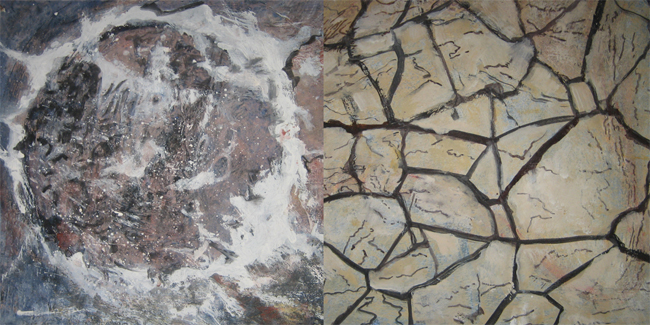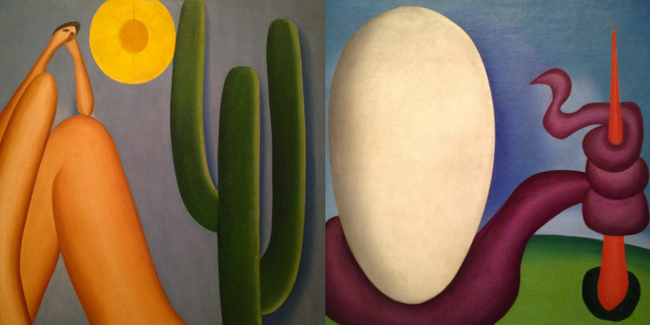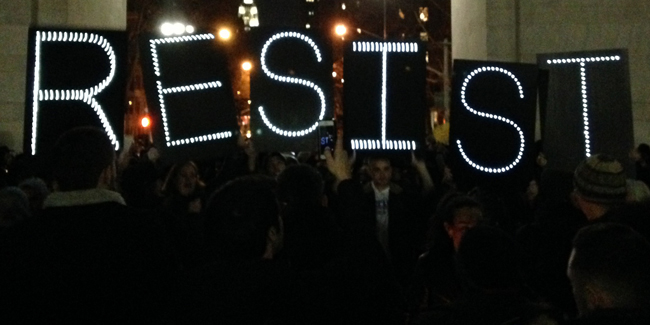Field Notes: Anthropophagy
Catherine Henke & Randee Silv
April 2018
 Catherine Henke (close-ups)
Catherine Henke (close-ups)
An image haunts me, for a fraction of a second, like a 3D world’s cracked skin, cracked ground… crack, crack, slowly becoming more cracked. Push it away with wet green. A bomb is exploding, like a nervous system ruptured from pressure too high or like a bad movie impression that could boomerang. Don’t let it come back.
 Abaporu 1928 & Urutu 1928, Tarila de Amaral (close-ups)
Abaporu 1928 & Urutu 1928, Tarila de Amaral (close-ups)
abá (man) poro (people) ‘u (to eat) from the Tupí-Guraraní language. Novelist, poet & a founder of the Brazilian modernist movement, Oswald de Andrade titled a painting given to him by Tarila do Amaral, Abaporu (Man Eats). He went on to write the Anthropophagite (Cannibalist) Manifesto to address forging one’s identity in the postcolonial world. “Only anthropophagy unites us. Socially. Economically. Philosophically. The one and only world principle.” Devouring & digesting external influences for cultural emancipation. Reclaiming a wholeness, an identity by recognizing diversity by amplifying engagements by exposing the limits of what’s already been (mis)understood by recognizing what others don’t. Transforming the deadly viper into a water spirit.
Saturn Devouring His Son, 1819-1823, Goya (close-up)
Today we are hearing about the artistic and cultural anthropophagy related to the empowerment of Latin America in front of the supremacy of the occidental world. But far before Claude Levi Strauss was writing, “Rousseau saw the origin of social life in the feeling that drives us to identify with others. After all, the easiest way to identify others with oneself is to eat them.” Goya was painting Saturn (Cronos) Devouring His Son. Saturn devoured his children lest they dismiss him. Again power matters. Zeus himself is a survivor of cannibalism.
That painting was done directly onto Goya’s dining room wall at Quinta del Sordo when he was 73. He had never intended for any of the murals he painted there to be seen by the public. No notes on them have survived. After his death, the 14 “black paintings” were moved to the Prado in Madrid and then given titles. Is it from fear of being overthrown that “Saturn” ate each “child?” Or is the grown figure being victimized aware of what’s happening and trying to fight back? Is this a social critique of brutality as Goya witnessed Spain being devoured by its autocracy, this frightened, crazed demon swallowing up its own people?
________________________________________________________________________________________________
Visual artist Catherine Henke, originally from Geneva (Switzerland), chose to live and work in Montemor-o-Novo (Portugal).This radical change in her living conditions encouraged her to learn about rural life and the practice of organic agriculture. She has developed knowledge related to the rhythms of nature and to an ecological consciousness. Her art practice comprises varying uses of numerous techniques, such as painting, sculpture, ceramic and mixed media installation.
To read more by Catherine Henke, click here
Abstract painter Randee Silv is the editor of Arteidolia and swifts & slows: a quarterly of crisscrossings. Silv also constructs wordslabs that emerge as gestures reshaped, juxtaposed, tilting fragments that alter between what is and isn’t. They have appeared in Posit, Urban Graffiti, Maudlin House, Sensitive Skin, Bone Bouquet & Otoliths. Her chapbook, Farnessity (2018), has been published by dancing girl press.
To read more by Randee Silv, click here

